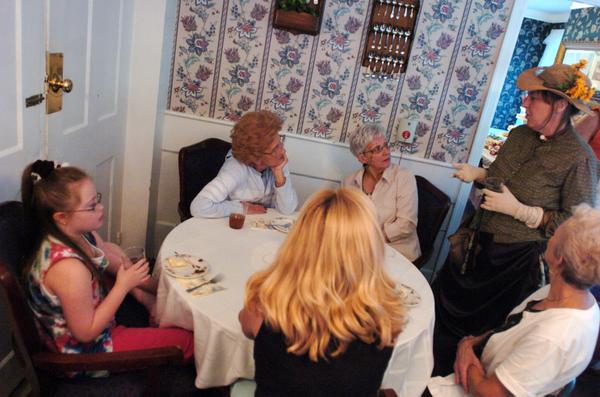

Re-enactors put love of history to life
By Megg Crook/Staff Writer
Fri Sep 28, 2007, 11:52 AM
Woburn - They love to dress up and, for a few hours, pretend to be someone else. Their clothes aren’t called costumes but rather “period-correct clothing.” They are re-enactors and there are so many of them in Woburn that they have formed their own guild under the leadership of lifelong re-enactor and expert 18th Century tailor, Darlene Wigton .
The Woburn Living History Guild is a newly formed subcommittee of the Woburn Historical Society. Wigton chairs the subcommittee and sits on the Society's board. The Guild itself has three subcommittees -- militia, re-enactors and living history players who enjoy the occasional re-enactment role.
For those serious about re-enacting, there are many opportunities in Woburn, and the guild doesn’t limit itself to just the city.
“We’ve done burial ground tours and the Pathway of the Patriots,” said Robin Longendyke, a Woburn re-enactor. Last weekend Longendyke played a woman from the Victorian era, greeting guests at the Tidd Home open house. “With the militia I’ve gone to Charlestown. We will back up the militia and fill it in with more bodies for them, like the extra on a set.”
Longendyke said that for her, there are no challenges to pretending to be someone else; it all comes easily. She enjoys meeting and socializing with people she would not normally meet, history enthusiasts like herself.
“Sometimes I like just pretending I’m somebody else so I can be like a child again,” Longendyke said. “And I really love history.”
There are several types of re-enacting, according to Darlene Wigton, a re-enactor who conceived and organized the Woburn Living History Guild. Some people choose to dress in clothing that looks like it belongs in the century they are pretending to be from, but others design and create dresses and men’s suits that are period-correct and accurate right down to the type of buttons and fabric used. They are not costumes, however.
“Costume is a funny word,” Wigton said. “One definition of it is anything that isn’t normal street wear … but we don’t want people confusing theater costumes and accuracy. Thought has to go into not just getting the correct fabrics but also considering who you are playing. Would that person have worn silk or just have linen available?”
One of the challenges in re-enacting is creating the clothing accurately and, sometimes, without spending a lot of money. To make the dresses perfectly accurate, sometimes real silk fabric is used, and a dress could cost as much as $200, Wigton said. Often, however, fabric that captures the look of silk without the expense is used instead.
The dress that Longendyke made for the Tidd Home open house was elaborate, but not overly extravagant, for its time. With four layers, it would have been a dress worn for calling on friends, or other social functions like church.
“Everybody was impressed with it,” Longendyke said. “Some wanted to know if I’d inherited it, if it had been in my family for 100 years.”
It took Longendyke a month to complete her dress. Wigton, who is a professional tailor, said she could complete a man’s shirt in about four hours, but spends her time mostly fabricating full British and American Colonial Era uniforms and opulent period clothing for the gentry.
Though parts of Longendyke's dress, like the inseams, are machine-sewn, any stitching that is visible outside the dress needs to be hand-sewn like it would have been done in the 18th century.
“It’s a challenge to create an 18th-century period dress,” Wigton said. “I enjoy the sewing of it. It’s very interesting to see; you start with a flat piece of fabric, and as you’re cutting and sewing it turns into a gown.”
Because Woburn’s Historical Society is just starting to become active, it is still small, and members welcome anyone interested in history or re-enacting.
"We're always looking for new members" said Wigton. "We are not a closed society, but a clothes society" quipped Longendyke.